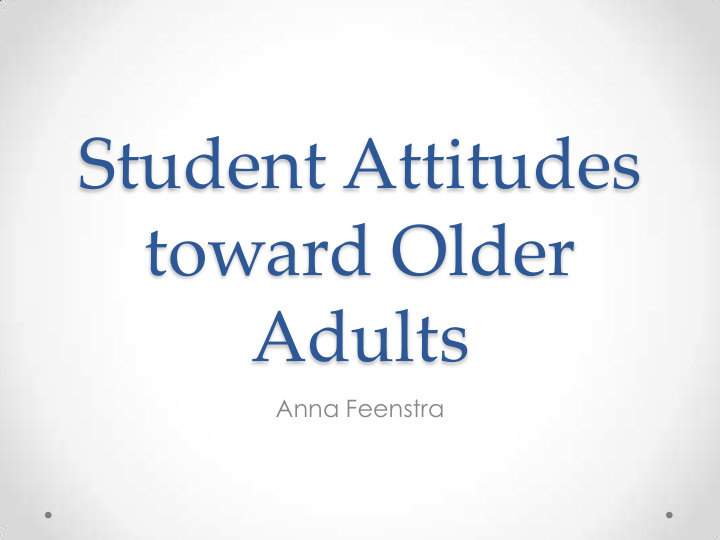



Student Attitudes toward Older Adults Anna Feenstra
Student Attitudes toward Older Adults • Background • Purpose • Methods and sample • Results • Discussion • Limitations
Background • Aging of the American population • By 2050, about one fifth of the population will be age 65 or older • Illnesses increase with old age; almost half of all hospital visits are made by people 65 years or older.
Background, cont. • Not enough people trained in geriatrics in the U.S. • Geriatric nursing lacks appeal to many nurses and students
Background: Ageism Many people have • negative attitudes toward aging and the aged. One theory is the terror • management theory (TMT) Ageism is present at all • levels of society, in the U.S. and other countries Older adults seen as • physically or mentally deficient
Associated Factors • Younger age • Male gender • Lack of experience with older adults
What has been done? • Integration of gerontology material into curriculum • Dedicated gerontology courses • Instructors in both classroom and clinical setting • Exposure to well elders
Purpose of Study • Determine the attitudes of nursing students toward older adults and if they change over the course of the nursing program.
Methods • HSIRB approval obtained • Pre-test post-test single group design o Beginning of sophomore semester (T1) o End of sophomore semester (T2) o End of program (T3) • Kogan’s Old People scale (KOP) • Demographic questionnaire
Sample • T1 and T2 o n=40 o 75% female (n=30) o 80% under 25 years of age o Most had had prior experience with older adults o 87.5% Caucasian • T3 o n=35 o 80% female (n=28) o 86% under 25 years of age (n=30) o Most had prior experience with older adults o 94.3% Caucasian
Results KOP scores throughout study (whole cohort) 90 85 84.2 80 KOP positive Scores 76.03 75.75 75 KOP negative 71.28 70 65 60 T1 T3
Results, cont. KOP scores throughout the study (10 students) 120 100 99.3 80 78.2 KOP positive 73 Scores 69 68 61 60 KOP negative 40 20 0 T1 T2 T3
Discussion • Results consistent with previous research • Higher scores on negative items consistent with Kogan’s original research
Limitations • Not all participants paired (only T1 and T2) • Change in class composition • Sampling issues • The scale: old, may be outdated
Implications/Recommend ations • More research needed on factors affecting attitudes toward older adults • Increased emphasis on gerontology education • Gerontology education should be integrated throughout curriculum • Aging specialists as faculty
Conclusion • Increase in older adult population • Negative attitudes toward older adults in society • Great need for geriatric-educated health practitioners • Increase in positive attitudes through education • Necessity of gerontology-oriented, integrated nursing curricula.
A final thought… “Who will care for a segment of society to which almost everyone will someday belong?” (Ryan & McCauley, 2005, p. 6)
References American Association of Colleges of Nursing (2006). Caring for • and aging America: A guide for nursing faculty. Retrieved from http://www.aacn.nche.edu/geriatric- nursing/monograph.pdf Bernardini Zambrini, D.A, Moraru, M., Hanna, M., Kalache, A., & • Macias Nuñez, J. F. (2008). Attitudes toward the elderly among students of health care related studies at the University of Salamanca, Spain. Journal of Continuing Education in the Health Professions, 28 (2), 86-90. Bodner, E., (2009). On the origins of ageism among older and • younger adults. International Psychogeriatrics, 21 (6), 1003- 1014. Cozort, R.W., (2008). Student nurses’ attitudes regarding older • adults: Strategies for fostering improvement through academia. Teaching and Learning in Nursing, 3 , 21-25. Ferrario, C.G., Freeman, F.J., Nellett, G., & Scheel, J. (2008). • Changing nursing students’ attitudes about aging: An argument for the successful aging paradigm. Educational Gerontology, 34 , 51-66.
Goncalves, D.C., (2009). From loving Grandma to working with • older adults: Promoting positive attitudes towards aging. Educational Gerontology, 35 , 202-225. Haight, B.K,. Christ, M.A., & Dias, J.K., (1994). Does nursing • education promote ageism? Journal of Advanced Nursing, 20 , 382-390. Henderson, J., Xiao, L., Siegloff, L., Kelton, M., & Peterson, J., • (2008). ‘Older people have lived their lives’: First year nursing students’ attitudes towards older people. Contemporary Nurse, 30 (1), 32-45. Holroyd, A., Dahlde, S., Fehr, C., Jung, P., & Hunter, A. (2007). • Attitudes toward aging: Implications for a caring profession. Journal of Nursing Education, 48 (7), 374-380. Jansen, D.A., & Morse, W.A., (2004). Positively influencing student • nurse attitudes toward caring for elders: Results of a curriculum assessment study. Gerontology & Geriatrics Education, 25 (2), 1- 14. Kogan, N., (1961). Attitudes toward old people: The development • of a scale and an examination of correlates. Journal of Abnormal and Social Psychology, 62 (1), 44-54.
Koh, L., (2012). Student attitudes and educational support in • caring for older people – A review of literature. Nurse Education in Practice, 12 (1), 16-20. McKinlay, A., & Cowan, S., (2003). Student nurses’ attitudes • toward working with older patients. Journal of Advanced Nursing, 43 (3), 298-309. Ryan, M., & McCauley, D., (2005). We built it and they did not • come: Knowledge and attitudes of baccalaureate nursing students toward the elderly. Journal of the New York State Nurses Association, Fall/Winter 2004/2005 , 5-9. Soderhamm, O., Lindencrona, C., & Gustavsson, S.M., (2001). • Attitudes toward older people among nursing students and registered nurses in Sweden. Nurse Education Today, 21 , 225- 229. U.S. Census Bureau, (2005). 65+ in the United States: 2005 . • Retrieved from http://www.census.gov/prod/2006pubs/p23- 209.pdf on April 5, 2012.
Recommend
More recommend